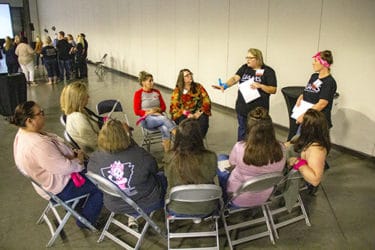Digital Health Stroke Program Reaches Patient Care Milestone
| Applause greeted Renee Joiner when she announced a long sought after achievement for Arkansas’ digital health stroke network — getting more than 50% of stroke patients from hospital arrival to treatment in 60 minutes or less.
Along with many other speakers, Joiner, director of the UAMS Institute for Digital Health & Innovation Stroke Program, addressed the more than 300 health care professionals attending the institute’s 2019 Stroke Program Conference in Hot Springs on Sept. 25-26.
The Arkansas stroke patients Joiner spoke of were treated through the program’s statewide digital health network of 55 hospitals. Since its beginning in 2008, the network has used digital health technology in the form of a live high-definition video connection to reduce the time it takes for a stroke patient to receive treatment with alteplase, a powerful clot-busting blood thinner. The technology also allows for the quick transfer of data and imaging, and the digital health network also reduces the time it takes to get to a stroke neurologist who can diagnose and help them.
Joiner presented some impressive data, too, about the number of patients the program now treats in collaboration with the hospitals in the network.
Starting from zero in 2008, the program in 2018 had 1,333 digital health consults and 503 patients treated with alteplase. “Door-to-needle time,” the time between the arrival of the patient in an Emergency Department and the time the patient receives alteplase, has fallen from an average of 126 minutes to 66 minutes in that same time period.
“Our goal is a door-to-needle time of less than 60 minutes for 50 percent of our patients,” Joiner said. “We hit it in 2019 in 52% of stroke cases with a time of under 60 minutes. That’s huge. I am so excited about that.”
Joiner gave a lot of credit for that success to all the mock drills and training the network hospital members have done, actually exceeding the number of consults.
Of all the patients treated through the institute’s Stroke Program, 68% completely recovered from their strokes or recovered with minor impairments. Patients discharged to home increased last year from 40.9% to 55%.
The program also outperformed national averages for stroke treatment. Nationally, 45.4% of patients were able to get up and walk after treatment compared to 68% in the UAMS stroke program; and in-hospital deaths from stroke averaged 8.25% nationally compared to 3.9% at UAMS.
The economic impact is positive, too. Joiner said the program saved more than $29 million in health care costs last year alone.
“That’s a conservative estimate,” she said. “I think it’s a model for the nation, and I am very proud to be a part of it. The other thing we try to do is keep patients as close to home as possible. Our goal is to expand the number of receiving sites across the state and expand health care providers’ capability to keep stable alteplase patients at their home hospital when possible. We want to keep them close to home.”
After Joiner spoke, Margaret Tremwel, M.D., Ph.D., stroke program medical director at Washington Regional Hospital in Fayetteville, discussed how to determine whether a stroke-causing clot was blocking a large blood vessel or a small one. If a small hospital in the Stroke Program’s network can discern the difference with greater speed and efficiency, then patients who need a procedure to remove a clot can be identified and routed more quickly to a facility that can do that.
“We are developing a stroke system of care that not only will be able to detect if they’ve had a stroke in the first place but will also determine the best place they can go to get the care they need,” she said.
Similarly, Sanjeeva Onteddu, M.D., the Stroke Program’s medical director, reviewed for the conference audience the best ways to assess patients to determine whether they are candidates for transfer to UAMS (or hospital with similar capabilities), the receiving hospital’s own intensive care unit, or a regular patient room. More efficient and precise assessments at the first hospital should result in faster transfers when patients need a higher center for care.
Onteddu also highlighted that UAMS and the Stroke Program are now part of National Institutes of Health (NIH) StrokeNet, NIH StrokeNet is made up of 25 regional centers across the United States and involves more than 200 hospitals in conducting small and large clinical trials and research studies to advance stroke treatment, stroke prevention, and recovery and rehabilitation following a stroke.
He said four clinical trials are being done at UAMS thorough StrokeNet.
“Underserved patients in Arkansas and the region will have improved access to research opportunities that might benefit them because UAMS is now a part of the StrokeNet,” Onteddu said. “Having more treatment options is always a good thing for the patient and for the provider.”
Other featured speakers at the conference included Jo Thompson, chief financial officer at the Arkansas Department of Health; James Bledsoe, M.D., chief physician specialist in the Section of Emergency Medical Services at the Arkansas Department of Health; Greg Brown, Arkansas Department of Health chief of the Trauma, Public Health Preparedness/Emergency Response and Emergency Medical Services Branch; Rawle Seupaul, M.D., chair of the UAMS Department of Emergency Medicine; and Jennifer Smith, J.D., R.N., Wright Lindsey and Jennings LLP.
Other session topics were pediatric stroke, survivor case studies, community outreach, stroke prevention and other aspects of stroke care.
Awards were presented to several hospital stroke programs and individuals working in them. To read about the awardees, click here.


